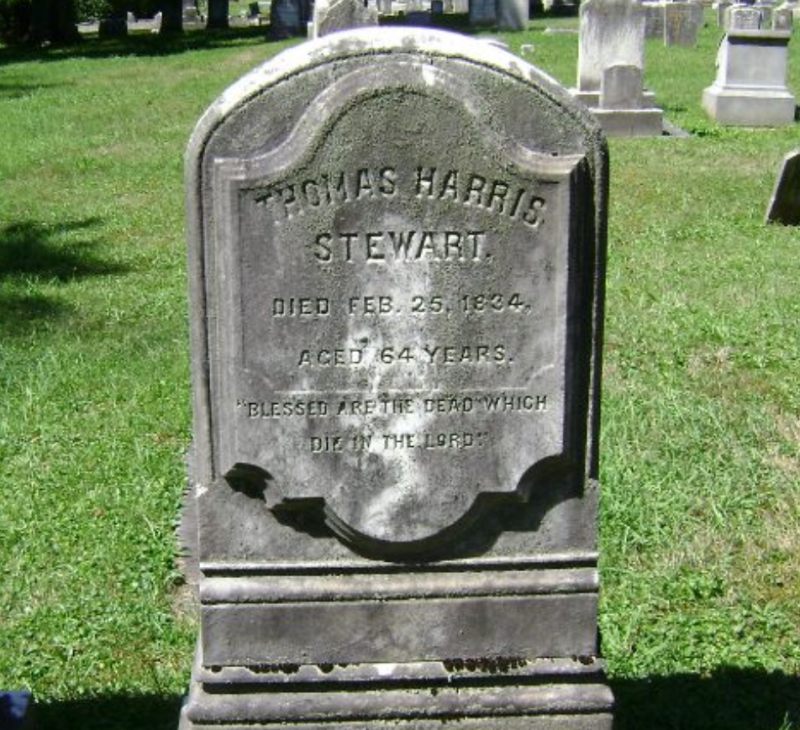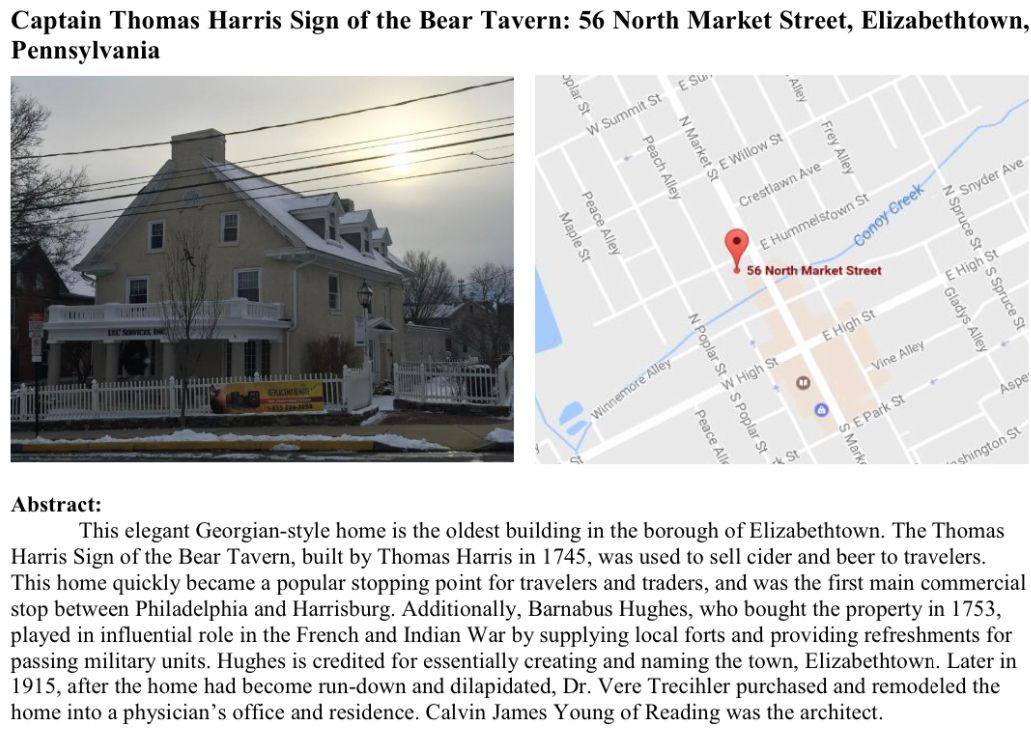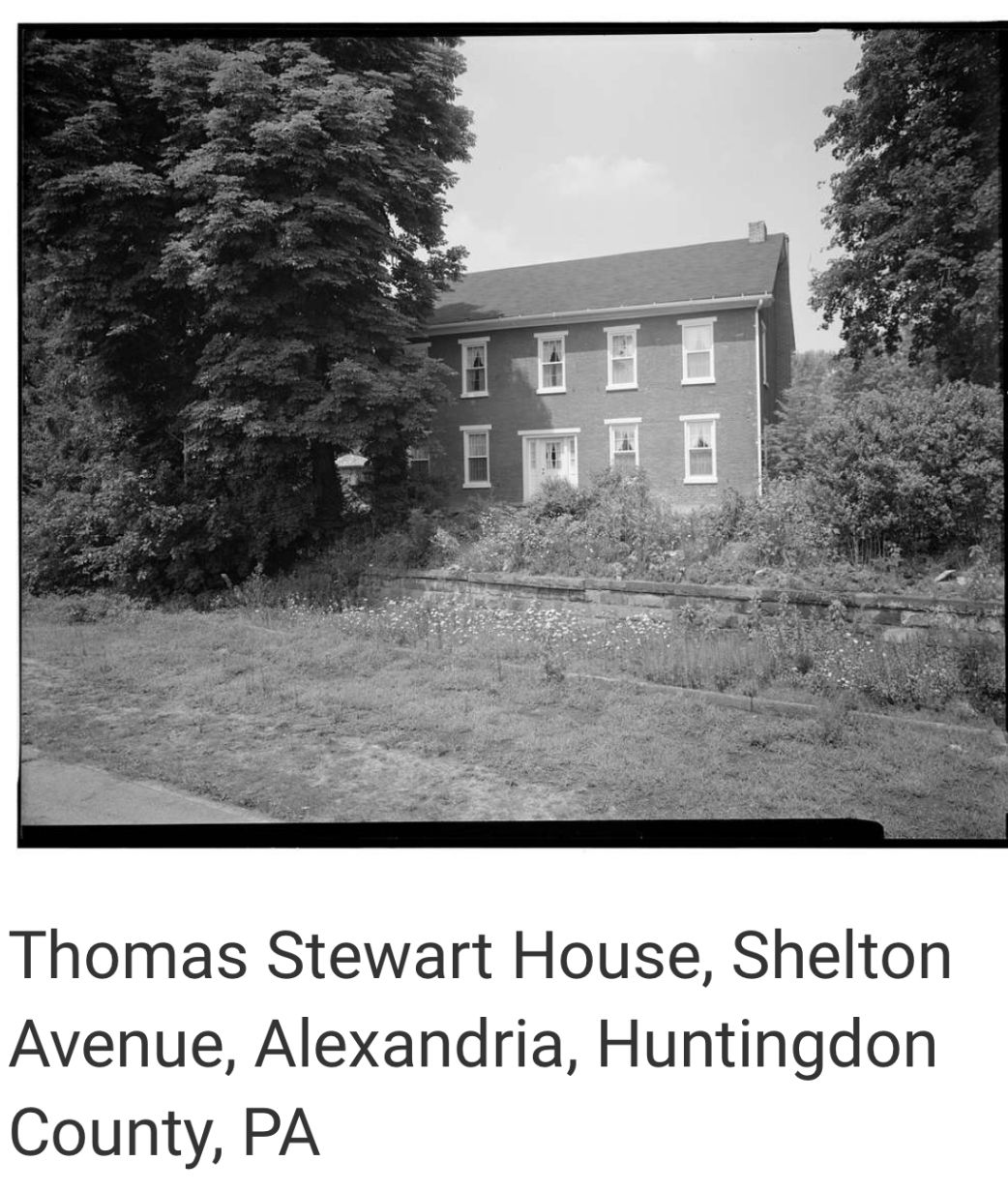Thomas Harris Stewart, the third son and fifth child of Col. George and Margaret (Harris) Steuart, was born Feb. 5, 1767, in Harford (then Baltimore) County, Maryland, in or near Cross Eoads (now Churchville). He was named for his maternal grandfather.
The first extant notices of him after birth arc as " Tommy " in his uncle Dr. John Archer's ledger of charges for professional services to his father's family. These run along between the years 1772 and 1775. Probably earlier notices might have been found in a previous ledger which is lost.
In 1775 his father moved to Tuscarora Valley, Pa., taking Tommy along. Ho was then about eight years old. Here he experienced the vicissitudes of tho family until his father's death, Aug. 13, 1787, and, we may suppose, received such education as could be had in the neighborhood.
About that time, probably, he left home and his work on the farm, or at the mills of his grandfather, to learn the tanning trade with a Mr. Turbett—probably Col. Thomas Turbett, who lived a few miles away on the eastern side of the valley. Col. Turbett was a revolutionary hero and an honored citizen.
Having finished his trade, T. H. Stewart started the business of tanning, on his own account, near his father's homestead, and Nov. 5, 1795, married Anne Gemmil, daughter of John Gemmill3, deceased, and Elizabeth (Porter) Gemmi II, whose home was on the Kilmarnock farm, a few miles above Lewktown on the south side of the Juniata river, and just below what is now Granville station, P. R. R.
After their marriage, Thomas H. Stewart1 and his wife Anne took up their residence at Harris' (afterwards Doyle's) Mills in Milford township, Mifflin (now Juniata) Co., where the former continued his tanning business; and here they remained about six years, during which time four (or probably five) children were born, two of whom were twins.
By the will of his grandfather, Thomas Harris, who died Deo. 4,1801, T. H. Stewart became heir to the mill property, on condition that he pay his mother £800, and was made joint-executor with her in carrying out the provisions of the will and settling the estate. But Dr. John Archer, of Maryland, had a claim on some of the land, and this claim had to bo satisfied, which was done March 24,1810, by the execution of a deed. The property was afterwards sold to Richard Doyle and then it passed to the Okesons. The mill now belongs to a man named Telfer.
The family then moved to Alexandria, Pa., a growing village of which Mrs. Stewart's mother was the "proprietress." Here Mr. Stewart started a tannery, built the first brick house of the place, gained considerable wealth and became a prominent citizen. Through her father's will and an amicable division of his property by the Gemmill heirs, made June 3, 1798, and through subsequent changes and exchanges, Mrs. Stewart also added considerably to the material possessions of the household. Among these possessions we find at least one slave, called Black Mattie, who was either the daughter or the wife of Wm, Hill. After her marriage, Black Mattie moved to Beaver, Pa.
As early at least as 1808, Thos. H. Stewart was appointed a justice of the peace, and with scarcely any interruption he continued in this office until the day of his death. He was a strong Jeffersonian Democrat and advocated the rights of individuals and of States, as opposed to the claims of an overwhelming central control in the hands of the general Government; and to this party most, if not all, of his sons subsequently adhered. It is said that at r»ne time Squire Stewart allowed his partizanship to run so high as to temporarily lose his official position, through a violation of the law. This was " while attending to business in an adjoining district, where he owned property, on election day, when a Governor was to be elected, and he could not get home. He voted in the district where ho was, thus running the risk of losing his offico. He was quickly informed on, and his commission taken from him, but as soon as he had voted ho wroto to the Governor who had been elected, explained the matter fully, and his commission was restored to him," or rather renewed, " he having been just onehalf a day without it." So reports his daughter Margaret.
Squire Stewart was also an active member and elder of the Presbyterian church—his connection being first with the Hartslog congregation and afterwards with that of Alexandria, which began to worship separately about 1814, and was fully organized in 1819. The pastor of the Hartslog congregation in those days was the Kev. John Johnston, who was also pastor of the Huntingdon church. He was a man of marked ability, but a difference of political sentiments between him and the Alexandria people led to the withdrawal of the latter from his ministry and their forma, tion into a separate organization. Rev. James Thompson, who became Squire Stewart's son-in-law, was pastor of the Alexandria Church from April 19, 1819, to Oct. 8, 1830, when he died. Then Hartslog and Alexandria reunited at Alexandria and called the Rev. Sam'l Wilson, who served as pastor from 1832 to 1837, and was succeeded by the Rev. John McKinney (1838 to 1848) and the Rev. George Elliot (1849 to 1858).
Thomas H. Stewart1, says his daughter, Mrs. Shaiffer, was of medium height, had dark hair (which was partially gray, as she remembers him) and blue eyes, and was of a sparo habit. One of his eldest daughters, Margaret Harris3, says "he was of good height, and good face, dark hair, no prominent constitutional disease, a mild calm temperament, a kind heart, and generous to a fault. He had also a good common education." Mrs. Kinsloe says, " Papa was a real Harris, looked like W. W. of Fulton, Pa., very handsome."
All accounts show that though his education was not remarkable he stood above the average of his associates in intelligence, energy and influence, maintained a good character, both as a man and as a Christian, and, having served his generation well, fell asleep in Jesus, " happily " taking his departure " in the hope of a joyful resurrection." His daughter Peggy says, " His death was a peculiarly triumphant one."
He died of pleurisy, at Alexandria, Feb. 25, 1832, and was buried in the Alexandria cemetery, where a tombsone was erected to his memory, though the date on it (1834) is erroneous. On this tombstone is inscribed the text, " Blessed are the dead which die in the Lord."
Source:
Colonel George Steuart and his wife Margaret Harris: their ancestors and ... By Robert Stewart
Thomas Harris Stewart, the third son and fifth child of Col. George and Margaret (Harris) Steuart, was born Feb. 5, 1767, in Harford (then Baltimore) County, Maryland, in or near Cross Eoads (now Churchville). He was named for his maternal grandfather.
The first extant notices of him after birth arc as " Tommy " in his uncle Dr. John Archer's ledger of charges for professional services to his father's family. These run along between the years 1772 and 1775. Probably earlier notices might have been found in a previous ledger which is lost.
In 1775 his father moved to Tuscarora Valley, Pa., taking Tommy along. Ho was then about eight years old. Here he experienced the vicissitudes of tho family until his father's death, Aug. 13, 1787, and, we may suppose, received such education as could be had in the neighborhood.
About that time, probably, he left home and his work on the farm, or at the mills of his grandfather, to learn the tanning trade with a Mr. Turbett—probably Col. Thomas Turbett, who lived a few miles away on the eastern side of the valley. Col. Turbett was a revolutionary hero and an honored citizen.
Having finished his trade, T. H. Stewart started the business of tanning, on his own account, near his father's homestead, and Nov. 5, 1795, married Anne Gemmil, daughter of John Gemmill3, deceased, and Elizabeth (Porter) Gemmi II, whose home was on the Kilmarnock farm, a few miles above Lewktown on the south side of the Juniata river, and just below what is now Granville station, P. R. R.
After their marriage, Thomas H. Stewart1 and his wife Anne took up their residence at Harris' (afterwards Doyle's) Mills in Milford township, Mifflin (now Juniata) Co., where the former continued his tanning business; and here they remained about six years, during which time four (or probably five) children were born, two of whom were twins.
By the will of his grandfather, Thomas Harris, who died Deo. 4,1801, T. H. Stewart became heir to the mill property, on condition that he pay his mother £800, and was made joint-executor with her in carrying out the provisions of the will and settling the estate. But Dr. John Archer, of Maryland, had a claim on some of the land, and this claim had to bo satisfied, which was done March 24,1810, by the execution of a deed. The property was afterwards sold to Richard Doyle and then it passed to the Okesons. The mill now belongs to a man named Telfer.
The family then moved to Alexandria, Pa., a growing village of which Mrs. Stewart's mother was the "proprietress." Here Mr. Stewart started a tannery, built the first brick house of the place, gained considerable wealth and became a prominent citizen. Through her father's will and an amicable division of his property by the Gemmill heirs, made June 3, 1798, and through subsequent changes and exchanges, Mrs. Stewart also added considerably to the material possessions of the household. Among these possessions we find at least one slave, called Black Mattie, who was either the daughter or the wife of Wm, Hill. After her marriage, Black Mattie moved to Beaver, Pa.
As early at least as 1808, Thos. H. Stewart was appointed a justice of the peace, and with scarcely any interruption he continued in this office until the day of his death. He was a strong Jeffersonian Democrat and advocated the rights of individuals and of States, as opposed to the claims of an overwhelming central control in the hands of the general Government; and to this party most, if not all, of his sons subsequently adhered. It is said that at r»ne time Squire Stewart allowed his partizanship to run so high as to temporarily lose his official position, through a violation of the law. This was " while attending to business in an adjoining district, where he owned property, on election day, when a Governor was to be elected, and he could not get home. He voted in the district where ho was, thus running the risk of losing his offico. He was quickly informed on, and his commission taken from him, but as soon as he had voted ho wroto to the Governor who had been elected, explained the matter fully, and his commission was restored to him," or rather renewed, " he having been just onehalf a day without it." So reports his daughter Margaret.
Squire Stewart was also an active member and elder of the Presbyterian church—his connection being first with the Hartslog congregation and afterwards with that of Alexandria, which began to worship separately about 1814, and was fully organized in 1819. The pastor of the Hartslog congregation in those days was the Kev. John Johnston, who was also pastor of the Huntingdon church. He was a man of marked ability, but a difference of political sentiments between him and the Alexandria people led to the withdrawal of the latter from his ministry and their forma, tion into a separate organization. Rev. James Thompson, who became Squire Stewart's son-in-law, was pastor of the Alexandria Church from April 19, 1819, to Oct. 8, 1830, when he died. Then Hartslog and Alexandria reunited at Alexandria and called the Rev. Sam'l Wilson, who served as pastor from 1832 to 1837, and was succeeded by the Rev. John McKinney (1838 to 1848) and the Rev. George Elliot (1849 to 1858).
Thomas H. Stewart1, says his daughter, Mrs. Shaiffer, was of medium height, had dark hair (which was partially gray, as she remembers him) and blue eyes, and was of a sparo habit. One of his eldest daughters, Margaret Harris3, says "he was of good height, and good face, dark hair, no prominent constitutional disease, a mild calm temperament, a kind heart, and generous to a fault. He had also a good common education." Mrs. Kinsloe says, " Papa was a real Harris, looked like W. W. of Fulton, Pa., very handsome."
All accounts show that though his education was not remarkable he stood above the average of his associates in intelligence, energy and influence, maintained a good character, both as a man and as a Christian, and, having served his generation well, fell asleep in Jesus, " happily " taking his departure " in the hope of a joyful resurrection." His daughter Peggy says, " His death was a peculiarly triumphant one."
He died of pleurisy, at Alexandria, Feb. 25, 1832, and was buried in the Alexandria cemetery, where a tombsone was erected to his memory, though the date on it (1834) is erroneous. On this tombstone is inscribed the text, " Blessed are the dead which die in the Lord."
Source:
Colonel George Steuart and his wife Margaret Harris: their ancestors and ... By Robert Stewart
Inscription
" Blessed are the dead which die in the Lord."
Gravesite Details
It has been noted that Stewart actually died in 1832.
Family Members
-
![]()
George Harris Stewart
1797–1798
-
![]()
John Stewart
1798–1798
-
![]()
Elizabeth Gemmill "Eliza" Stewart Thompson
1799–1877
-
![]()
Margaret Harris Stewart
1799–1888
-
![]()
John Gemmill Stewart Sr
1801–1884
-
![]()
Thomas Harris Stewart Jr
1804–1839
-
![]()
Dr Zachariah Gemmill Stewart
1805–1863
-
![]()
George Harris Stewart
1809–1883
-
![]()
William Brown Stewart
1811–1843
-
![]()
Anna Maria Stewart Kinsloe
1814–1889
-
![]()
Mary Linn Stewart Shaiffer
1817–1901
-
Harriet Newell Stewart
1819–1820
Advertisement
Records on Ancestry
Sponsored by Ancestry
Advertisement




















